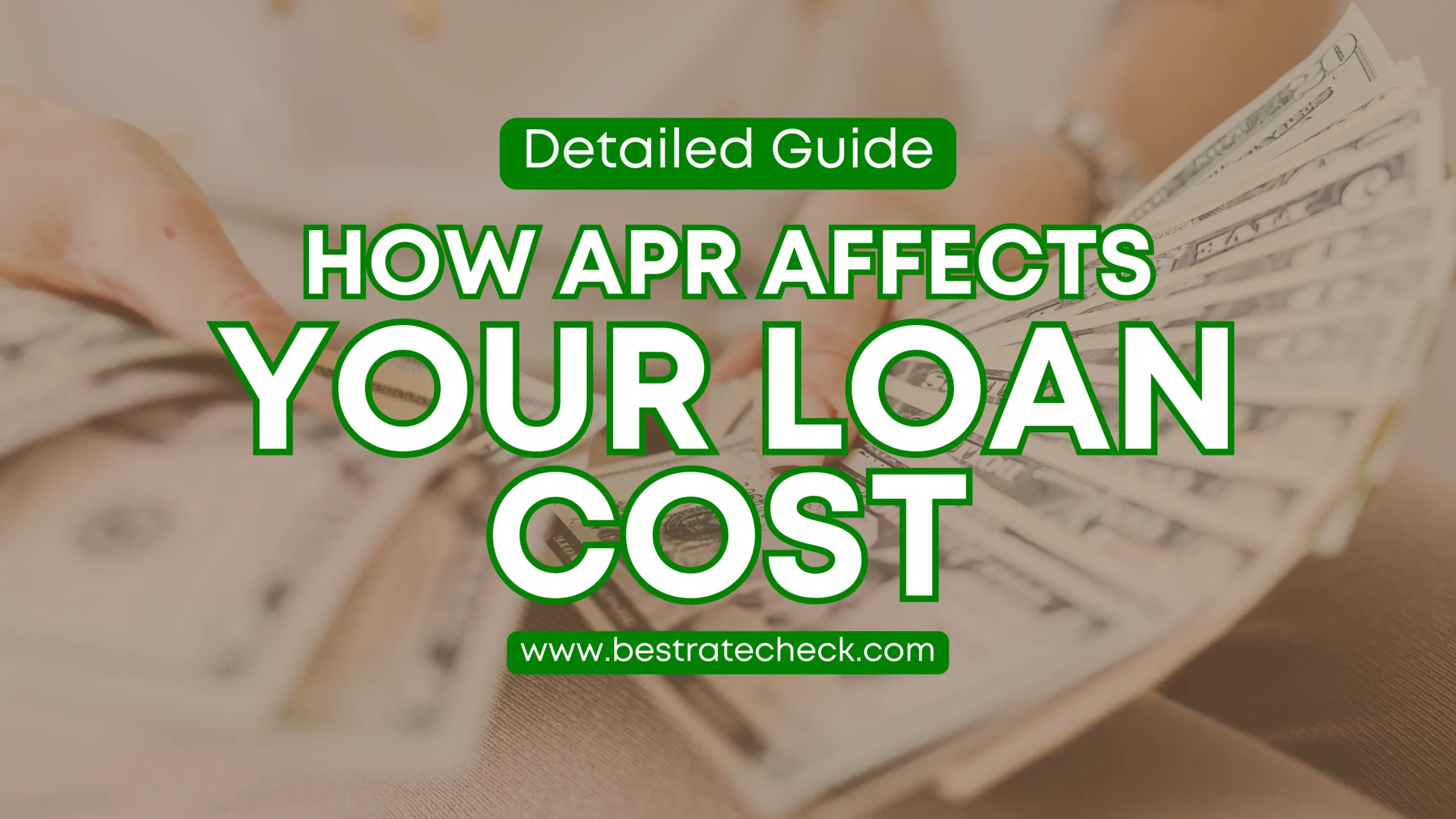APR or annual percentage rate is the yearly cost of borrowing money. It is a percentage of the principal amount added to what you owe. This term gets tossed around whenever loans are being discussed. The lower the APR, the better. You can use it to compare different loan offers.
Whenever you’re taking a loan, APR is like a torch in a dark room. It reveals all the true costs you’ll be paying and hidden fees, if any. So, it not only includes the interest rate, but also all additional charges like origination fees and closing costs. This way, you know everything you’re paying.
Usually, APR is important when you’re considering a new credit card, loan, or mortgage, and you wish to save money. In this guide, we’re going to cover everything related to annual percentage rate, how it differs from interest rate, and how you can use it to compare loan offers.
What is annual percentage rate (APR)?
In simpler terms:
- APR includes all the costs you’ll be paying to borrow a loan per annum.
- The interest rate plus all other charges and fees are combined in this number.
- For credit cards, APR is the yearly interest rate on outstanding balance, and generally, there are no additional fees that are included.
- When you’re shopping around for loans or credit cards, APR can help you compare and find the best offer.
- Essentially, a lower APR translates to lower cost for borrowing the money.
How do per annum interest rates work?
Per annum interest rates are for a year. So, the monthly interest rate you’ll be paying equals (interest)/12. For example, if the annual interest rate is 20 percent, on every monthly payment, you’ll need to pay back the principal plus 1.7 percent of the principal. Let’s say you borrowed $300 for 2 months. Each month, you need to pay back $152.55, which includes the interest.
APR is also an annual rate. The only difference is that interest rates are just interest rates—APRs are a measure of fees too. If the interest is of compounding type, you’ll be charged interest on both—the principal and any interest accrued.
How does APR work on a loan?
APR is the true, real cost of borrowing a loan. It is like a complete measure of what you’ll be paying. It provides an apples-to-apples cost comparison between two loans. This rate will vary a lot, depending on the lender you choose, amount you borrow, repayment term, and your credit score.
Some lenders might be charging very low interest rates to attract borrowers, but if the APR is high, you can clearly say that the lender is charging high fees, overall increasing the cost of the loan. However, even with APR, not all costs are included. Here’s what you’ll miss out on:
- Application fees
- Late payment penalties
- Prepayment penalties
- Defaulting charges
How does APR work on credit cards?
In a credit card, APR might not mean the same as other loans. As we already mentioned above, APR on a credit card is the yearly interest you need to pay on any balance you carry. So, it includes the interest rate and any standard fees associated with it. Overall, just the complete picture.
Now for a credit card, APR can be fixed or variable. Fixed rates remain same throughout the life of the loan, and the monthly payments are more predictable. Whereas, with variable rates, the APR will fluctuate over time. Mostly, variable APRs are tied to an index like the federal prime rate.
The interest is calculated on the owed amount, and it’s added to the total balance. Again, on the next day, interest is charged on the new balance. This keeps repeating. If you pay back the balance in full before your credit card bill is due, there will be no interest. This is called the grace period.
A lower APR is generally better. But, it doesn’t include late fees, cash withdrawal fees, or other extra charges. Also, for different types of purchases—balance transfers, cash advances, etc—the APR will be different. So, understand the terms and conditions of your card carefully.
APR vs. APY
Both APR (annual percentage rate) and APY (annual percentage yield) are used to measure interest, but they serve different purposes and they’re calculated differently:
| Characteristic | APR | APY |
| Purpose | It is the annual cost of borrowing money. | It is the annual earnings on your savings or investments. |
| Inclusion of Fees | Interest rate and all other fees are included | It is just the rate of return you get from interest. |
| Compound Interest | Doesn’t include the effects of compound interest. | Includes the effect compound interest has on the effective yield. |
| Usage | Used for informing borrowers about the cost they’ll be paying to borrow the loan. | It is used by banks, credit unions, brokerage firms, etc. to show how much interest savers will earn if they deposit money. |
What factors affect APR?
The APR a lender will offer you is not some arbitrary number. It depends on factors that you can control. Usually, your credit score, income, credit history, and current debt levels play a role. But, apart from that, the type of loan can also have an influence on the APR for a loan or credit card.
Most of all, your credit score is important. The higher your score is, the lower APR you’ll get. That’s because credit scores are built over time, by repaying loans you took in the past. This signals to the lender that you’re creditworthy, low-risk, and will repay the loan on time.
Your age and employment status are considered too. You must be at least 18 years old to get approved for a loan or credit card. Whatever the factors may be, a lender is always required to disclose the APR before any agreements are signed.
What is a good APR rate?
Depending on your credit score, the definition of a good credit card will vary. For someone who has an excellent credit score, an APR below 10 percent is considered very good. On an average, APR on credit cards are around 21.19 percent. So, anything below this is automatically considered good.
Also, for those who have lower credit scores, an APR of 18-25 percent can be considered good. For credit cards, if you’re going to always pay back the balance in full before the bill is due, APR shouldn’t matter much.
Is APR a bad measurement for payday loans?
Payday loans are short-term, high-interest loans that let you borrow smaller amounts. You can get the funds instantly, and you have to repay in full on your next payday. There are no credit checks, and documentation requirements are minimal, which make them even more accessible.
The APRs for these types of loans are sometimes higher than 400 percent! Looking at it from the outside, the high APR makes it look like you’re going to get robbed by the lender. However, APRs are slightly irrelevant in the context of payday loans.
That’s because APR is the annual percentage rate or the annual costs of borrowing a loan. And payday loans are usually due in 2-3 weeks. So, whatever the APR, it isn’t high when considered monthly. For example, you took a $500 loan for 1 month at an APR of 200 percent.
The monthly interest will be 16 percent. So, overall, you’ll have to pay back $583. While this is still on the higher end, during emergencies, or when you’re low on credit and still need the money, you may get them.
Tips for lowering your APR
- Negotiate with your issuer: You can call and request the lender or credit card provider to approve you for a lower APR. If you have a strong payment history, they might agree.
- Build your credit score: Improve your score and check your credit report regularly for any gaps or errors that can be overcome over time with strategic financial planning.
- Consider balance transfers: Balance transfer cards allow you to transfer your balance to a card with a very low or sometimes 0% introductory APR, usually valid for 12-18 months.
- Use promotional offers: At times, lenders offer better rates to promote their services so keep an eye. During an emergency, it can be useful if you already know which loan to get.
- Set up autopay: Lenders may offer you reduced interest rates if you approve autopay.
- Consolidate debt: To improve your credit score, combine your debts into one loan at a lower interest rate. You’ll be able to pay back faster, and the interest will be cut down.
Want low APR? Try Best Rate Check
Best Rate Check is an online platform that lets you get pre-approved with multiple lenders through a single, secure application. You can borrow personal loans, title loans, cash advances, payday loans, and installment loans. After getting multiple loan offers, you can compare the APR.
Summarizing everything
In summary, APR or annual percentage rate is the cost you pay for borrowing money through a loan or credit card. It includes interest rate and all major fees that are charged. Overall, you’ll get a complete idea on how much you’re going to pay for the loan or credit.
Frequently Asked Questions
The interest rates for online personal loans depend on an individual’s credit score. For those with great credit scores between 720 and 850, an interest rate of 10.73-12.50% is common.
Finance charges are a small amount which are charged for processing your loan. However, APR includes both interest rate and any finance charges.



